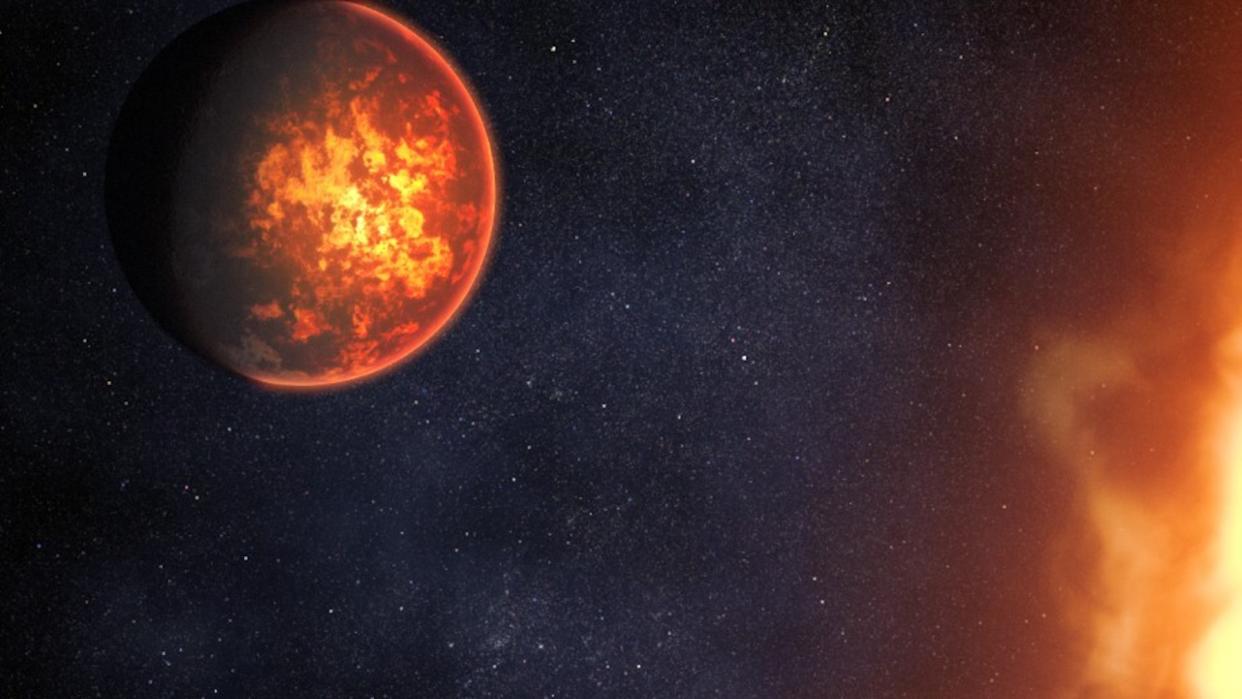Strange, red-glowing planet may be 'melting from within,' scientists report

A newly discovered planet in a faraway star system appears to be erupting with so many volcanoes, it glows a fiery red when seen from space. No planet like this has ever been observed before, researchers say, and follow-up observations will be required to confirm the strange world's existence.
The newfound planet, named TOI-6713.01, is the innermost world in a known planetary system with two other worlds orbiting an orange dwarf star roughly 66 light-years from Earth. The rocky planet is slightly bigger than Earth and zips around the 5 billion-year-old star every 2.2 days, astronomers reported in a study published in The Astronomical Journal in April.
Observations with NASA's planet-hunting Transiting Exoplanet Survey Satellite (TESS) suggest the rocky planet's surface is covered with molten lava from hundreds of volcanoes spewing on its surface. The temperature there exceeds 4,200 degrees Fahrenheit (2,300 degrees Celsius).
"This means the planet literally glows at optical wavelengths," Stephen Kane, an astrophysicist at the University of California, Riverside who led the discovery, told Universe Today. "It was one of those discovery moments that you think, 'wow, it's amazing this can actually exist," he added in a statement.
Astronomers said the neighboring planets, which orbit the star from farther away, have gravitationally squashed the incandescent world's orbit from a circle to an oval shape. So, in its short orbit around the star, TOI-6713.01 is constantly pulled and pushed by the gravity of its two neighboring planets and their central star — creating what astronomers describe as "a perfect tidal storm." This tug-of-war sparks enormous internal friction and heat within the newfound planet, which it releases via exploding volcanoes on its surface, the researchers wrote.
Related: James Webb telescope detects 1-of-a-kind atmosphere around 'Hell Planet' in distant star system
It's possible that light from background stars mimics telltale signatures of the flaming orb seen by TESS. However, if the presence of TOI-6713.01 is confirmed with follow-up observations, it could be an interesting target to study the extreme tidal effects experienced by planets. Such dynamics haven't been a focus of exoplanet research so far, Kane said.
"This teaches us a lot about the extremes of how much energy can be pumped into a terrestrial planet, and the consequences of that," Kane said in the statement. "There have been several cases of terrestrial planets that are close to their star and heated by the energy from the star, but very few cases where the tidal energy is melting the planet from within," he told Universe Today.
related stories
—'It could be profound': How astronomer Wendy Freedman is trying to fix the universe
—James Webb telescope discovers oldest black hole in the universe
In our own pocket of the cosmos, Jupiter's innermost moon Io is in a similar tug-of-war between the gas giant's immense gravity and smaller pulls from the two neighboring moons Europa and Ganymede. The routine flexing has caused hundreds of active volcanoes to explode on Io's surface, likely for the entire 4.57 billion-year history of the solar system. TOI-6713.01, however, senses 10 million times more tidal energy than Io, the new study found.
"This is a terrestrial planet that I would describe as Io on steroids," Kane said in the statement.
In the coming months, Kane and his team will measure the mass of the radiating planet, which would tell them just how much material is available to erupt as volcanoes and reveal clues about how the sizzling world formed and evolved.

